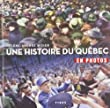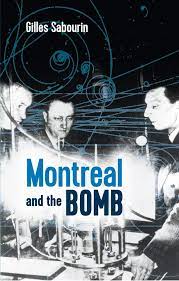-
-
By High, Steven2022., McGill Queens University Press Call No: NEW QWF 971.4281 H638d Availability:1 of 1 At Your Library Summary Note: Point Saint-Charles, a historically white working-class neighbourhood with a strong Irish and French presence, and Little Burgundy, a multiracial neighbourhood that is home to the city’s English-speaking Black community, face each other across Montreal’s Lachine Canal, once an artery around which work and industry in Montreal were clustered and by which these two communities were formed and divided. Deindustrializing Montreal challenges the deepening divergence of class and race analysis by recognizing the intimate relationship between capitalism, class struggles, and racial inequality. Fundamentally, deindustrialization is a process of physical and social ruination as well as part of a wider political project that leaves working-class communities impoverished and demoralized. The structural violence of capitalism occurs gradually and out of sight, but it doesn’t play out the same for everyone. Point Saint-Charles was left to rot until it was revalorized by gentrification, whereas Little Burgundy was torn apart by urban renewal and highway construction. This historical divergence had profound consequences in how urban change has been experienced, understood, and remembered. Drawing extensive interviews, a massive and varied archive of imagery, and original photography by David Lewis into a complex chorus, Steven High brings these communities to life, tracing their history from their earliest years to their decline and their current reality. He extends the analysis of deindustrialization, often focused on single-industry towns, to cities that have seemingly made the post-industrial transition. The urban neighbourhood has never been a settled concept, and its apparent innocence masks considerable contestation, divergence, and change over time. Deindustrializing Montreal thinks critically about locality, revealing how heritage becomes an agent of gentrification, investigating how places like Little Burgundy and the Point acquire race and class identities, and questioning what is preserved and for whom.
-
-
c2010., McGill-Queen's University Press Call No: QWF 971.428 M657e Availability:1 of 1 At Your Library Series Title: Studies on the history of Quebec Volume: 23.Summary Note: "This book has been published with the help of a grant from the Canadian Federation for the Humanities and Social Sciences, through the Aid to Scholarly Publications Programme, using funds provided by the Social Sciences and Humanities Research Council of Canada." "McGill-Queen's University Press acknowledges the support of the Canada Council for the Arts for our publishing program. We also acknowledge the financial support of the Government of Canada through the Book Publishing Industry Development Program (BPIDP) for our publishing activities."--BOOK JACKET.
-
-
-- Black nation :2013., Adult, Between the Lines Edition: eBook ed. Summary Note: "In the 1960s, for at least a brief moment, Montreal became what seemed an unlikely center of Black Power and the Caribbean left. In October 1968 the Congress of Black Writers at McGill University brought together well-known Black thinkers and activists from Canada, the United States, Africa, and the Caribbean -- people like C.L.R. James, Stokely Carmichael, Miriam Makeba, Rocky Jones, and Walter Rodney. Within months of the Congress, a Black-led protest at Sir George Williams University (now Concordia) exploded on the front pages of newspapers across the country -- raising state security fears about Montreal as the new hotbed of international Black radical politics"--Provided by publisher.
-
-
2013., Between the Lines Call No: QWF BLK 971.4 A935f Availability:1 of 1 At Your Library Summary Note: In the 1960s, for at least a brief moment, Montreal became what seemed an unlikely centre of Black Power and the Caribbean left. In October 1968 the Congress of Black Writers at McGill University brought together well-known Black thinkers and activists from Canada, the United States, Africa, and the Caribbeanpeople like C.L.R. James, Stokely Carmichael, Miriam Makeba, Rocky Jones, and Walter Rodney. Within months of the Congress, a Black-led protest at Sir George Williams University (now Concordia) exploded on the front pages of newspapers across the countryraising state security fears about Montreal as the new hotbed of international Black radical politics.
-
-
2019., John Aylen Books. Call No: FR 971.4 A311g Availability:1 of 1 At Your Library Summary Note: Peu d'établissements de Montréal peuvent se vanter d’avoir une histoire et un « pedigree » aussi riches que ceux du Centre de soins prolongés Grace Dart. L'histoire remonte à la Protestant House of Industry and Refuge, que les Redpath, les Molson et autres familles philanthropiques bien établies de l’époque ont fondée en 1863 sur des terres agricoles éloignées du coeur de la ville afin d’y accueiller des démunis dans un environnement sain et où régnait une hospitalité bienveillante. La photographie de la couverture montre la « Old People's Home » originale. L'histoire remonte également à 1907 lorsque, en l'honneur de sa fille Grace décédée de la tuberculose, le chimiste Henry Dart a fondé l'hôpital pour les patients démunis souffrant de la tuberculose; la photo de l’établissement figure sur la page couverture arrière. Les deux institutions de l’ère victorienne se sont adaptées à l'évolution rapide des besoins du monde moderne à mesure que les sciences médicales réalisent des avancées. Au même moment, la Révolution tranquille transformait l’approche caritative aux soins de santé du Québéc en systèmes axés sur l'efficacité. Les deux institutions ont fini par unir leurs forces, formant un troisième chapitre de cette histoire remarquable. Tout au long de ce long parcours, il y a toujours eu deux constantes: l'amour et la bonté. .
-
-
John Aylen Books Call No: 971.4 A311g Availability:1 of 1 At Your Library Summary Note: Few Montreal institutions can boast the history and pedigree of today's Grace Dart Extended Care Centre. The story goes back to the Protestant House of Industry and Refuge, which the Redpaths, Molsons, and other prominent philanthropic families founded in 1863 on distant farmland to house the poor in a clean and nurturing environment. The front cover shows the original "Old People's Home." The story also goes back to 1907 when, in honour of his deceased daughter Grace, chemist Henry Dart established the hospital depicted on the back cover for destitute tuberculosis patients. Both institutions adapted to rapidly changing needs as medical science advanced, as the Victorian world transitioned into a modern one, and as the Quiet Revolution transformed Quebec health care from private charity to coordinated efficiency. These two institutions eventually joined forces, forming a third chapter in this extraordinary story, Throughout history, however, there has been one constant: love and care.
-
-
2016., University of Ottawa Press Call No: 819.13 S279j Edition: ed. Availability:1 of 1 At Your Library
-
-
2012., Véhicule Press Call No: QWF 940.53 B967l Availability:1 of 1 At Your Library Summary Note: The Second World War came hard on the heels of a devastatingDepression in which families struggled to survive.Life on the HomeFrontpaints a poignant portrait of a city coping with the demandsof war. Montrealers, along with other Canadians, were being askedfor more sacrifice but this time it would include sending their sons,brothers, fathers and husbands off to war. Montrealers had toUse it Up, Wear it Out, Make it Do, and Do Without· as one slogancautioned, and this they did. Many women went to work for the firsttime and often enjoyed the heady success of doing a manœs job·and earning a regular salary.Life on the Home Frontdescribes how dissent was also an ever-presentreality. Montreal was often awash with anti-war banners and angryspeeches which kept the police and journalists busy. Prime MinisterWilliam Lyon Mackenzie King had to walk a fine line in keeping thecountry together and united at a time of grave crisis.All was not gloom and doom, however. Servicemen passing throughMontreal as well as locals could enjoy the most vibrant nightlifein Canada. The cozy relationship between city officials, the policeand the owners of disorderly houses· as well as the shady characterswho ran gambling establishments gave the name Sin City·to Canadaœs metropolis.
-
-
[2017], Shoreline Call No: 971.4 W684m Edition: ed. Availability:1 of 1 At Your Library Summary Note: "The author has taken 1909 and the old Montreal Star newspaper to show us Montreal of 107 years ago. In quotes from The Star and comments, he chose 1909, the end of the Edwardian Period, where the news was of the Cannon Royal Commission into municipal corruption, the 'Back to Montreal' weekend, and a typhoid epidemic. We can see how citizens coped in poor conditions and how they enjoyed summer and winter outdoor fun. We can see municipal problems as well as humorous events that caught a reporter's eye. We see how far and not-so-far Montreal has come in the last 100 years.".
-
-
c2017., [s.n.] Call No: SC 971.428 B442m Availability:1 of 1 At Your Library Summary Note: details a magical period in the history of Montreal, Quebec and Canada. From the 1860œs to the 1930œs Montrealœs Merchant Princes built their grand estates at the foot of Mount Royal overlooking the city. From this unique neighborhood these residents presided over a social, commercial and industrial renaissance that joined a nation from coast to coast. The collective contribution of these families to the establishment and development of Canada is nothing less than remarkable. MONTREALœS GOLDEN SQUARE MILE A NEIGHBORHOOD highlights Montrealœs social and corporate heritage as one of the most significant contributions in the history of Canadaœs development. A Literary and photographic retrospective elaborating on the individual and family contributions to the building of a nation this volume features more than 600 historical images including over 350 images by Canadian photographic pioneer William Notman, the largest print publication of his work to date.
-
-
2014., Park Extension Historical Society Call No: 917.14 P235p Edition: ed. Availability:1 of 1 At Your Library








![Fear of a Black nation [eBook] : race, sex and security in sixties Montreal Fear of a Black nation [eBook] : race, sex and security in sixties Montreal](/Library/images/~imageCT76341.JPG)










